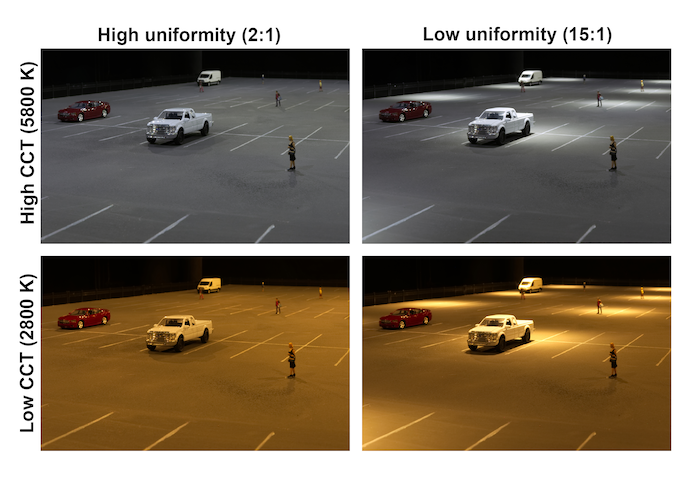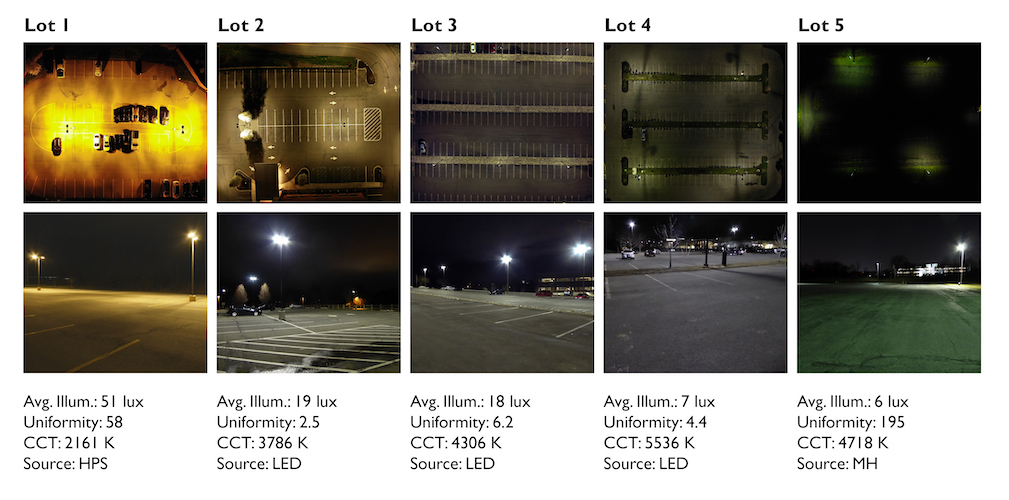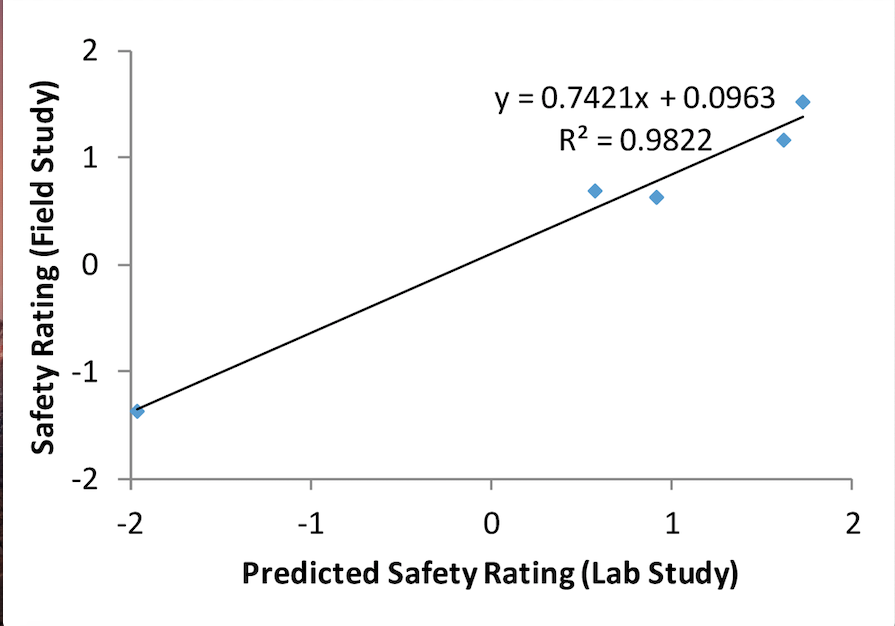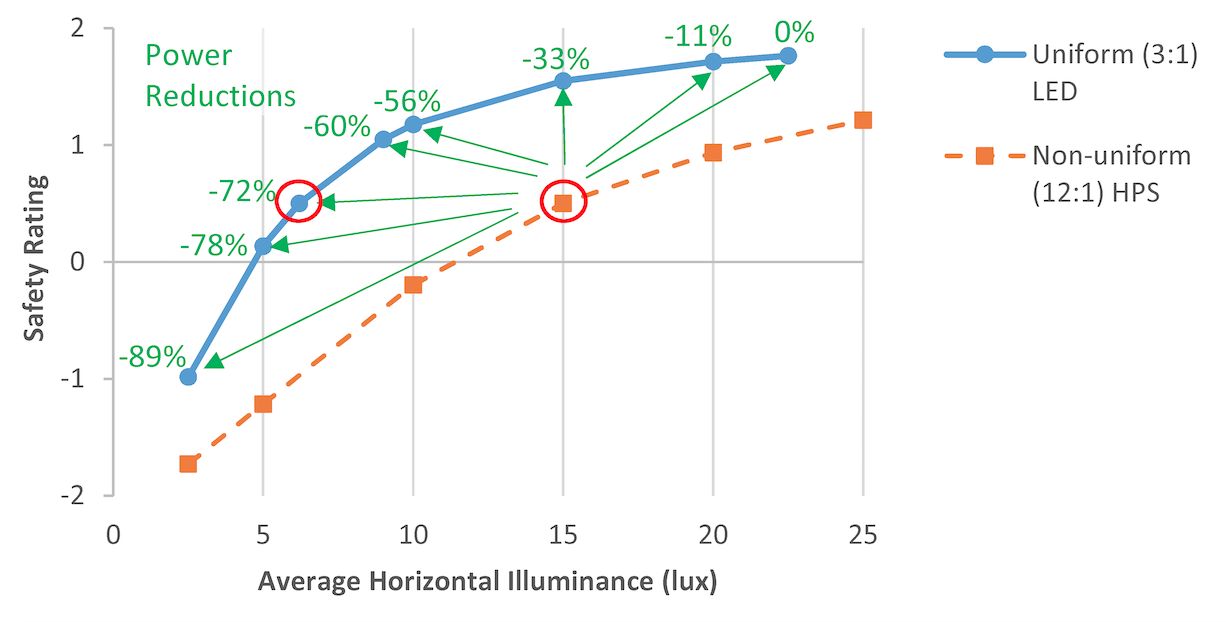
Moving toward uniformly safe parking lot lighting
July 6, 2020
By John D. Bullough, Jennifer A. Brons, Jeremy D. Snyder, Pierre Gallant and Robert Singlehurst
A new study could help engineers design improved systems.

Figure 1: Views of the scale model parking lot with different spectra and uniformity conditions.
Outdoor lighting serves multiple purposes. It should help pedestrians and drivers see well enough to avoid hazards. It should also contribute to overall perceptions of personal safety and security at night.
For outdoor parking lots, results from a number of studies suggest a minimum illuminance of 2 lux on the lot’s surface is sufficient for ensuring objects like small tripping hazards are visible to pedestrians. That said, even if people can see possible hazards, they still may not feel safe when walking across a parking lot in the dark.
As part of a project financially supported by Natural Resources Canada (NRCan) and members of the Lighting Energy Alliance (LEA), including U.S.-based Efficiency Vermont, Energize Connecticut, National Grid, Northwest Energy Efficiency Alliance and Commonwealth Edison, the Lighting Research Center (LRC)—part of Rensselaer Polytechnic Institute (RPI) in Troy, N.Y., focusing on advancing the effective use of lighting throughout society—recently carried out a study of lighting-related factors that influence people’s perceptions of safety and security in parking lots. The results could help engineers and specifiers design new lighting systems that respond to these visual needs while minimizing energy consumption.
Earlier LRC studies have investigated how the light level, spectral distribution (or colour) of the light source and the uniformity of illumination in a parking lot all affect people’s perceptions of safety. As might be expected, higher average light levels on a parking lot’s surface lead to perceptions of higher levels of safety.
Visitors to many different parking lots at night were asked whether they agreed the existing lighting reinforced their perceptions of personal security. As the light levels increased, so did their judgments about safety, but only up to an average illuminance of about 20 or 30 lux. Above this level, there were no further improvements in perceived safety.
To investigate the role of the lighting spectrum, LRC brought visitors to several university campus parking lots with different light levels, illuminated by high-pressure sodium (HPS), metal halide (MH) and light-emitting diode (LED) sources. For these different sources, both the light levels and the light spectra affected safety ratings. Perceptions of safety are based on sensations of brightness, which are greater for a white light source like LED or MH lamps than for HPS lamps, even when the measured light levels for all three options are the same.
This is because a person’s visual system responds strongly to short-wavelength (i.e. ‘blue’) light for perceived brightness. LED and MH sources provide more of this ‘content’ than HPS lights do.
A simple, imprecise metric for characterizing the amount of short-wavelength energy from a light source is the correlated colour temperature (CCT). Higher CCT sources appear whiter or bluer than those with a low CCT.
Another LRC study investigated uniformity of lighting. For this project, a parking lot was illuminated by a specific lighting installation where the ratio between the maximum and minimum illuminances (i.e. ‘max:min’) anywhere on the lot was either 10:1, a uniformity ratio common under sources like HPS, or 3:1, which is considered quite uniform in appearance. The participants’ judgments of safety were substantially higher under the more uniform illumination, even when the average illuminance was the same.
While these three factors—average illuminance, colour and uniformity—all affect how safe a pedestrian might feel when walking alone across an outdoor parking lot, the ways in which these factors interact with and affect each other had not been well understood in the past. To address this knowledge gap, LRC carried out a laboratory study using a scale model of a parking lot (see Figure 1, above) where the lighting could be changed from an average illuminance of 2.5 lux to 20 lux, from a CCT of 2,800 K to 5,800 K and from a max:min uniformity ratio of 2:1 to 15:1.
The results informed a mathematical model that can be used to predict the average rating of perceived safety along the following scale:
- –2: very unsafe
- –1: somewhat unsafe
- 0: neither safe nor unsafe
- +1: somewhat safe
- +2: very safe
The model has now been incorporated into a spreadsheet tool, dubbed the Parking Lot Lighting Safety Perception Calculator, which can be downloaded and used to compare installations that vary in light level, colour and uniformity.
Further, the predictions resulting from this lab study were put to the real-world test in a series of five parking lots (see Figure 2, below) at the Rensselaer Technology Park, a commercial campus owned by RPI. These lots were illuminated by different HPS, MH and LED systems, with different characteristics.

Figure 2: Five parking lots evaluated in the field study. Top row: plan view. Bottom row: view from observer’s perspectives.
Observers visited the parking lots in random order at night and provided their ratings of perceived safety, using the same scale as above. As it turned out, there was strong agreement between the predicted and the actual average rating values for each of the parking lots (see Figure 3, below). In other words, the mathematical model was shown to be validly predictive of how people will judge personal safety in parking lots at night.

Figure 3. Agreement between perceived safety ratings predicted by the lab study and the average ratings found in the real-world field study.
Based on the results of these studies, there is an opportunity to reduce energy use substantially when selecting parking lot luminaires that can achieve uniform illumination, i.e. with a low max:min illuminance ratio.
Using the new spreadsheet-based calculator, specifiers can compare results for their alternative lighting system designs. By way of example (see Figure 4, below), a lot where HPS lamps offer a CCT of 2,161 K, a 12:1 max:min uniformity ratio and average illuminance of 15 lux would be predicted to achieve an average perceived safety rating of +0.5—not quite ‘somewhat safe.’ If an LED luminaire with a CCT of 3,000 K could be used in a retrofit of the same site to produce an average illuminance of 6.2 lux and a max:min uniformity ratio of 3:1, then the average perceived safety rating could be maintained, but the installation would use 72% less energy. And by increasing the average illuminance to 9 lux, the perceived safety rating could be increased to +1 (‘somewhat safe’), while still saving significant energy (60%).

Figure 4: Using the Parking Lot Lighting Safety Perception Calculator, lighting specifiers can compare predicted safety ratings under different conditions to help optimize energy use. Each curve refers to a different uniformity ratio. The red circles illustrate +0.5 safety ratings for the scenarios described in the text. Arrows show potential energy savings for different LED retrofits achieving different safety ratings.
Such examples help demonstrate how important uniformity is, especially, to reinforcing people’s perceptions of safety and security through the use of outdoor lighting. Indeed, for engineers, uniformity provides powerful leverage in the design of both new and retrofit installations that (a) are economical for project owners and (b) a parking lot’s occupants will judge as safe.
John D. Bullough is director of transportation and safety lighting programs and a course instructor at RPI’s LRC. Jennifer A. Brons is director of design demonstrations, Demonstration and Evaluation of Lighting Technologies and Applications (DELTA) program manager and an adjunct assistant professor for LRC. Jeremy D. Snyder is former director of energy programs for LRC. Pierre Gallant is a standards engineer for NRCan. Robert Singlehurst is a team leader for NRCan. For more information, including a link to the Parking Lot Lighting Safety Perception Calculator, visit lrc.rpi.edu and search for ‘parking.’